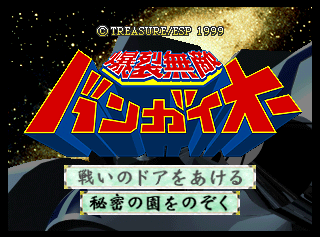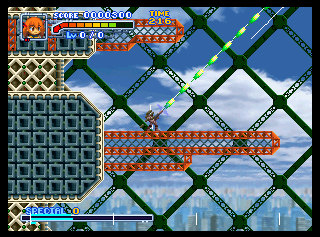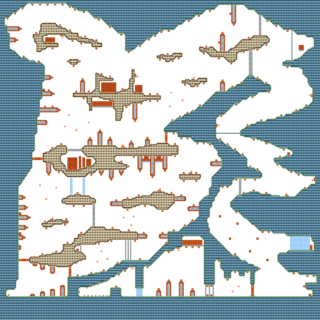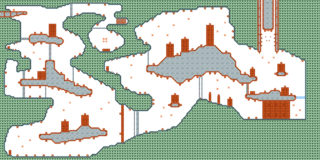Bakuretsu Muteki Bangaioh
| Bakuretsu Muteki Bangaioh |
|---|
|
Also known as: Explosive, Invincible Bangaioh
|
Bakuretsu Muteki Bangaioh is a dual-stick shoot-'em-up originally released as a Japan-only N64 title, and is significantly different in gameplay and script from the Dreamcast release a few months later. Only 10,000 cartridges were released, making it one of the rarest N64 titles.
Contents
Memory Usage
A debug memory usage display (bottom left of the screenshot) can be enabled with the below code and then pressing L + A + B + Start to toggle it on or off. This only needs to be activated once since this code saves to SRAM once the game makes a save.
| Version | GameShark code |
|---|---|
| Japan | 81145CA0 2A03 80145CA2 002A |
Unused Stages
There are three unused stages. The first two are remarkably similar to two existing stages in the game and contain placeholders for enemies not found in other map files. It is believed these are development versions of those stages.
The final unused stage is a relatively open field and does not contain any of the development placeholders found in the others. It is more likely this was an alternate final stage.
These unused stages do not have pointers linking them to a stage number index, and as a result there are no assigned background images, bosses, or scripts. As a result, the codes listed in each section to playtest each stage will cause each to use the backdrops and bosses of the stage they replace.
No order for these unused stages can be derived. Map stage assignment is completely arbitrary, most likely in the order that they were completed or by internal name. Without any reference for the naming, it is impossible to determine precisely what use each of these originally had.
Placeholder Tiles
All stages are built using 8×8 tiles contained in a tileset file. Ordinarily, all objects - your suit, enemies, buildings, items, etc. - are transparent. These tiles simply assign a property to indicate where the object should be loaded.
Prototype stages contained special placeholder images for some of these objects, most likely to aid in placing them. These are either bright orange or bright blue with white highlights when necessary. Interestingly, only your starting location, enemies, items, infostation, and the boss are contained in the placeholder tilesets. Other tiles, most notably buildings, are not included.
Unused Stage 1
Likely an early version of Stage 12, given the starting location and general layout. The boss is set in a position against the wall, which would imply this was a Koa boss stage. The most obvious modification in the finished Stage 12 is the boss area, which is no longer a corridor but a pit containing a suit. This stage uses placeholder tiles.
GameShark code 81096AA6 4DC8 will replace stage1 with unused1.
Unused Stage 2
It isn't entirely clear if this stage was a prototype of a final release stage. The boss is again positioned flush to a wall, implying Koa was again the boss. This stage uses placeholder tiles.
GameShark code 81096A9E 4DD0 will replace stage2 with unused2.
Unused Stage 3
This map is very simple, consisting of only two areas containing some fruit, several lasers protecting those optional areas, and the boss residing in the center of the stage. The boss area locks itself after you enter. For this reason, it is suspected this was a prototype arena for the final boss.
Unlike the first two unused stages, this one does not contain placeholder images for any of the object layer assignments. Also, each object uses only one tile to assign its properties instead of splitting across several tiles, as is the case with the multiple tile placeholder images.
GameShark code 81096A7A 4F28 will replace stage3 with unused3.
Development Text
| 9D078 |
|---|
G_DL G_OBJ_MOVEMEM G_OBJ_SPRITE G_OBJ_RECTANGLE G_BG_RECTCOPY G_BG_RECT1CYC G_NOP G_SETCIMG G_SETZIMG G_SETTIMG G_SETCOMBINE G_SETENVCOLOR G_SETPRIMCOLOR G_SETBLENDCOLOR G_SETFOGCOLOR G_SETFILLCOLOR G_FILLRECT G_SETTILE G_LOADTILE G_LOADBLOCK G_SETTILESIZE G_LOADTLUT G_RDPSETOTHERMODE G_SETPRIMDEPTH G_SETSCISSOR G_SETCONVERT G_SETKEYR G_SETKEYGB G_RDPFULLSYNC G_RDPTILESYNC G_RDPPIPESYNC G_RDPLOADSYNC G_TEXRECTFLIP G_TEXRECT G_OBJ_LDTM_RECT_R G_OBJ_LDTM_RECT G_OBJ_LDTM_SPRITE G_OBJ_LOADTMEM G_NOOP G_SPRITE2D_SCALEFLIP G_SPRITE2D_DRAW G_MOVEWORD G_SETOTHERMODE_H G_SETOTHERMODE_L G_ENDDL G_RDPHALF_1 G_TEXRECT_DONE G_OBJ_RECTANGLE_R G_OBJ_RENDERMODE G_SWITCH_UCODE Undefined ----------------------------------------RSP DL Log %08x: %08x %s Shade-TX-ZB-Tri Shade-TX-Tri Shade-ZB-Tri Shade-Tri TX-ZB-Tri TX-Tri ZB-Tri Tri Noop ---------------------------------------- RDP FIFO %08x: %08x %08x %s Debug = (%08x %08x %08x %08x %08x) -------- Assert!! -------- PC=%08x inp=%08x gfx0=0x%08x ----------------------------------------IMEM %04x : %08x %08x %08x %08x ----------------------------------------DMEM |
| 9AB34 |
sched.c |
The Bangai-O series
| |
|---|---|
| Nintendo 64 | Bakuretsu Muteki Bangaioh |
| Dreamcast | Bangai-O |
| Nintendo DS | Bangai-O Spirits |
- Pages missing developer references
- Games developed by Treasure
- Pages missing publisher references
- Games published by Entertainment Software Publishing
- Nintendo 64 games
- Pages missing date references
- Games released in 1999
- Games released in September
- Games released on September 3
- Games with unused areas
- Games with hidden development-related text
- Games with unused graphics
- Games with debugging functions
- Bangai-O series
Cleanup > Pages missing date references
Cleanup > Pages missing developer references
Cleanup > Pages missing publisher references
Games > Games by content > Games with debugging functions
Games > Games by content > Games with hidden development-related text
Games > Games by content > Games with unused areas
Games > Games by content > Games with unused graphics
Games > Games by developer > Games developed by Treasure
Games > Games by platform > Nintendo 64 games
Games > Games by publisher > Games published by Bandai Namco > Games published by D3 Publisher > Games published by Entertainment Software Publishing
Games > Games by release date > Games released in 1999
Games > Games by release date > Games released in September
Games > Games by release date > Games released in September > Games released on September 3
Games > Games by series > Bangai-O series




